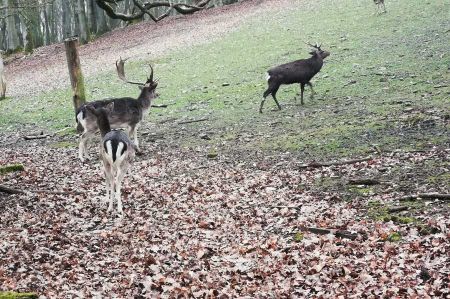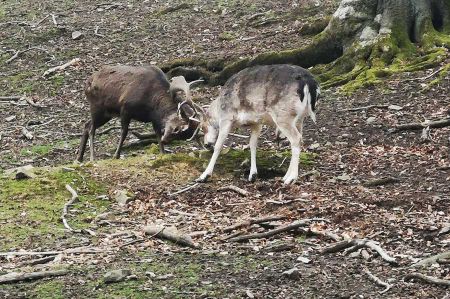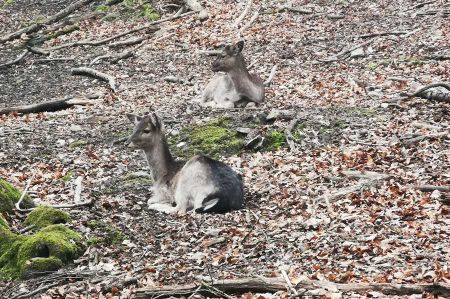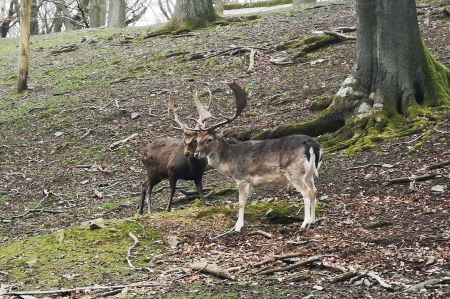Fallow deer in Hohenstein Park near Witten
- Written by Portal Editor
A Sunday hike along the Borbach near Witten had led us to the Hohenstein-Berger monument, where we took a short break with bread and tea that we had brought with us.
The chosen circular route should later lead us to the popular fallow deer enclosure in the park-like area in the middle of the Ruhr area. Fallow deer are diurnal and prefer to live in open landscapes in which small areas of forest alternate with agricultural areas. Precisely for this reason, fallow deer are very suitable for keeping as they are frugal, become familiar with people and show a largely compatible behavior with one another. Points that are particularly appreciated by animal lovers for observation. This is precisely why fallow deer are often kept in parks that are open to visitors all year round.
Just occasionally, when the animals are being fed by visitors, fallow deer do attack people. This aggressive behavior is almost entirely due to food envy. Most of the time the deer hit the feeder with their antlers in order to demand more food.
Did the Romans bring fallow deer to Europe?
 In southern Europe, fallow deer were hunted by people from the Stone and Bronze Age. Among other things, a high proportion of fallow deer bones can be found in the finds from some settlements from this period in the southern Balkans. Hittite depictions from the 2nd millennium BC can also be found in the area of today's Turkey due to lot of deer representations that can be interpreted as fallow deer. Originally the occurrence of fallow deer was probably limited to the Near East, including Asia Minor. But it was already introduced in other regions by the Romans.
In southern Europe, fallow deer were hunted by people from the Stone and Bronze Age. Among other things, a high proportion of fallow deer bones can be found in the finds from some settlements from this period in the southern Balkans. Hittite depictions from the 2nd millennium BC can also be found in the area of today's Turkey due to lot of deer representations that can be interpreted as fallow deer. Originally the occurrence of fallow deer was probably limited to the Near East, including Asia Minor. But it was already introduced in other regions by the Romans.
 Fallow deer are now at home in many regions of Europe because they were introduced by sovereigns as another large animal that could be hunted, especially during the period of absolutism. The largest stocks of fallow deer are in the UK today. The fallow deer are still kept in large gates in some regions. Fallow deer can now also be found outside Eurasia and also plays a major role in wild animal husbandry for meat production.
Fallow deer are now at home in many regions of Europe because they were introduced by sovereigns as another large animal that could be hunted, especially during the period of absolutism. The largest stocks of fallow deer are in the UK today. The fallow deer are still kept in large gates in some regions. Fallow deer can now also be found outside Eurasia and also plays a major role in wild animal husbandry for meat production.
The fallow deer a sacrificial animal of the Phoenicians?
 The spotted fur of the fallow deer was seen as a reflection of the starry sky. With the Phoenicians the fallow deer was therefore the preferred sacrificial animal in the cult around the god Baal-Hammon. The Greeks preferred to dedicate fallow deer to the goddess Artemis. In order to keep fallow deer available at all times, they were kept in special enclosures very early. The Phoenician and Greek colonization in the Mediterranean area between the 11th and 6th centuries BC led to the fact that the fallow deer was reintroduced in the coastal regions of what is now Marseilles, in the area of Carthage and Spain, where the fallow deer were probably extinct in the wild . How big the role of the fallow deer was in the cult of the Roman goddess Diana has not been conclusively clarified.
The spotted fur of the fallow deer was seen as a reflection of the starry sky. With the Phoenicians the fallow deer was therefore the preferred sacrificial animal in the cult around the god Baal-Hammon. The Greeks preferred to dedicate fallow deer to the goddess Artemis. In order to keep fallow deer available at all times, they were kept in special enclosures very early. The Phoenician and Greek colonization in the Mediterranean area between the 11th and 6th centuries BC led to the fact that the fallow deer was reintroduced in the coastal regions of what is now Marseilles, in the area of Carthage and Spain, where the fallow deer were probably extinct in the wild . How big the role of the fallow deer was in the cult of the Roman goddess Diana has not been conclusively clarified.
 However, fallow deer were used during the strong expansion of the Roman Empire between the 1st century BC and the 3rd century AD introduced throughout Roman rule, as shown by bone finds from excavations in Switzerland, southern Germany, England and Hungary, among others.
However, fallow deer were used during the strong expansion of the Roman Empire between the 1st century BC and the 3rd century AD introduced throughout Roman rule, as shown by bone finds from excavations in Switzerland, southern Germany, England and Hungary, among others.
In addition to being kept in show enclosures, fallow deer are also kept like livestock. On such deer farms with intensive pasture management and year-round additional feeding, between 10 and 20 fallow deer per hectare are kept. This attitude is primarily used for the production of animals. There are also sales markets for the bast skin that covers the growing antlers.
Please also read:
Balaton - Lake Balaton - more than an intermediate destination
The Venetikos River at the Grevena conglomerate gorge
-
 Meeting with Fallow dear in Witten
Meeting with Fallow dear in Witten
Meeting with Fallow dear in Witten
Meeting with Fallow dear in Witten
-
 Meeting with Fallow dear in Witten
Meeting with Fallow dear in Witten
Meeting with Fallow dear in Witten
Meeting with Fallow dear in Witten
-
 Meeting with Fallow dear in Witten
Meeting with Fallow dear in Witten
Meeting with Fallow dear in Witten
Meeting with Fallow dear in Witten
-
 Meeting with Fallow dear in Witten
Meeting with Fallow dear in Witten
Meeting with Fallow dear in Witten
Meeting with Fallow dear in Witten
-
 Meeting with Fallow dear in Witten
Meeting with Fallow dear in Witten
Meeting with Fallow dear in Witten
Meeting with Fallow dear in Witten
-
 Meeting with Fallow dear in Witten
Meeting with Fallow dear in Witten
Meeting with Fallow dear in Witten
Meeting with Fallow dear in Witten
-
 Meeting with Fallow dear in Witten
Meeting with Fallow dear in Witten
Meeting with Fallow dear in Witten
Meeting with Fallow dear in Witten
-
 Meeting with Fallow dear in Witten
Meeting with Fallow dear in Witten
Meeting with Fallow dear in Witten
Meeting with Fallow dear in Witten
-
 Meeting with Fallow dear in Witten
Meeting with Fallow dear in Witten
Meeting with Fallow dear in Witten
Meeting with Fallow dear in Witten
-
 Meeting with Fallow dear in Witten
Meeting with Fallow dear in Witten
Meeting with Fallow dear in Witten
Meeting with Fallow dear in Witten
-
 Meeting with Fallow dear in Witten
Meeting with Fallow dear in Witten
Meeting with Fallow dear in Witten
Meeting with Fallow dear in Witten
-
 Meeting with Fallow dear in Witten
Meeting with Fallow dear in Witten
Meeting with Fallow dear in Witten
Meeting with Fallow dear in Witten
-
 Meeting with Fallow dear in Witten
Meeting with Fallow dear in Witten
Meeting with Fallow dear in Witten
Meeting with Fallow dear in Witten
-
 Meeting with Fallow dear in Witten
Meeting with Fallow dear in Witten
Meeting with Fallow dear in Witten
Meeting with Fallow dear in Witten
-
 Meeting with Fallow dear in Witten
Meeting with Fallow dear in Witten
Meeting with Fallow dear in Witten
Meeting with Fallow dear in Witten
-
 Meeting with Fallow dear in Witten
Meeting with Fallow dear in Witten
Meeting with Fallow dear in Witten
Meeting with Fallow dear in Witten
-
 Meeting with Fallow dear in Witten
Meeting with Fallow dear in Witten
Meeting with Fallow dear in Witten
Meeting with Fallow dear in Witten
-
 Meeting with Fallow dear in Witten
Meeting with Fallow dear in Witten
Meeting with Fallow dear in Witten
Meeting with Fallow dear in Witten
https://www.alaturka.info/en/life/fauna/5325-fallow-deer-in-hohenstein-park-near-witten#sigProId00911b50a0

